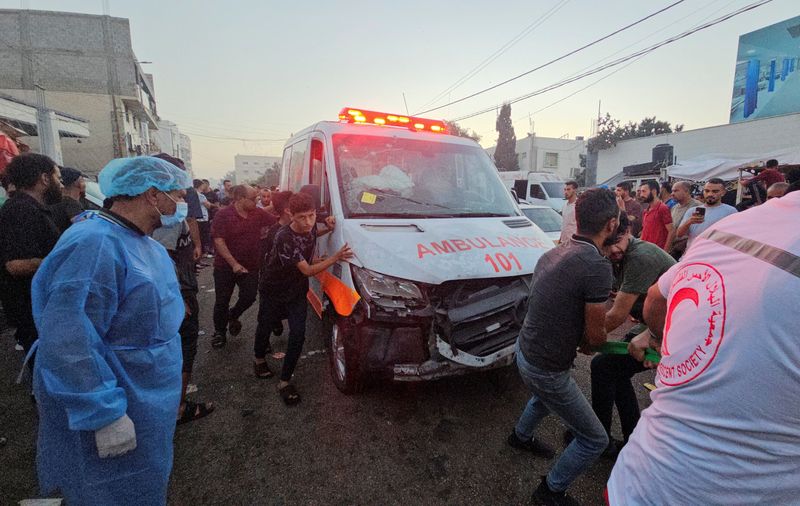US, Arab leaders to meet over Gaza as Palestinian deaths mount
2023.11.03 20:12

© Reuters. Palestinians pull an ambulance after a convoy of ambulances was hit, at the entrance of Shifa hospital in Gaza City, November 3, 2023. REUTERS/Anas al-Shareef
By Nidal al-Mughrabi, Simon Lewis and Suleiman Al-Khalidi
GAZA/AMMAN (Reuters) – Gaza health officials said 15 people were killed in an Israeli air strike on an ambulance that the military said targeted Hamas militants, and Washington’s top diplomat was due to hear Arab demands for a ceasefire in a meeting on Saturday in Jordan.
The Israeli strike hit an ambulance that was part of a convoy carrying injured Palestinians at Gaza’s biggest hospital, al-Shifa, health officials in the Hamas-run enclave said on Friday.
“Upon their arrival to al-Shifa, (Israel) directly targeted the convoy’s second vehicle, committing a terrible massacre that claimed the lives of 15 (people) and wounded more than 60,” health ministry spokesman Ashraf al-Qidra said.
Israel’s military said it had identified and hit an ambulance “being used by a Hamas terrorist cell” in the battle zone, and that a number of Hamas fighters were killed.
“We emphasize that this area is a battle zone. Civilians in the area are repeatedly called upon to evacuate southwards for their own safety,” the military said.
Hamas official Izzat El Reshiq said allegations its fighters were present were “baseless”. The military gave no evidence to support its assertion that the ambulance was linked to Hamas but said it intended to release additional information.
Reuters was unable to independently verify accounts from either side.
Israel has accused Hamas of concealing command centres and tunnel entrances in al-Shifa, something Hamas and the hospital denies.
Israel’s ground forces encircled Gaza City on Thursday after stepping up a bombing campaign it says aims at wiping out Hamas, after the militant group killed 1,400 people and took more than 240 others hostage in an Oct. 7 assault in southern Israel.
Israel last month ordered all civilians to leave the northern part of the Gaza Strip, including Gaza City, and head to the south of the enclave, which it has also continued to bomb.
Gaza’s living conditions, already dire before the fighting, have deteriorated further. Food is scarce, residents have resorted to drinking salty water, medical services are collapsing and Gaza health officials say more than 9,250 Palestinians have been killed.
The U.N. humanitarian office OCHA estimates that nearly 1.5 million of Gaza’s 2.3 million population are internally displaced.
‘CONTINUING FULL FORCE’
On a visit to the region, U.S. Secretary of State Antony Blinken met with Israeli Prime Minister Benjamin Netanyahu on Friday and called for a humanitarian pause in fighting that he said would facilitate work to release hostages while enabling Israel to defeat Hamas.
In a televised address, Netanyahu rejected the idea of a pause unless hostages are freed.
“I made clear that we are continuing full force and that Israel refuses a temporary ceasefire which does not include the release of our hostages,” Netanyahu said.
Blinken on Saturday will meet with the Saudi, Qatari, Emirati and Egyptian foreign ministers as well as Palestinian representatives in Amman, the Jordanian foreign ministry said.
The Arab leaders will stress the “Arab stance calling for an immediate ceasefire, delivering humanitarian aid and ways of ending the dangerous deterioration that threatens the security of the region”, the ministry said in a statement.
Washington has maintained robust military and political support for Israel, while calling on its ally to take steps to avoid civilian deaths and address Gaza’s humanitarian crisis.
The State Department said earlier this week that while in Jordan, Blinken would “underscore the importance of protecting civilian lives and our shared commitment to facilitating the increased, sustained delivery of life-saving humanitarian assistance to civilians in Gaza.”
Jordan is a staunch U.S. ally and shares a border with the West Bank and Israel. Concerned about potential for a wider conflict, Amman has boosted border security and asked Washington to deploy Patriot air defense systems.
SECOND OR THIRD FRONT
While Blinken was in Israel, the leader of Lebanon’s Iran-backed Hezbollah group warned the United States that if Israel did not stop its assault on Gaza then the conflict could widen into a regional war.
Sayyed Hassan Nasrallah, in his first speech since the Israel-Hamas conflict erupted on Oct. 7, also threatened the U.S., hinting his Iran-backed paramilitary group was ready to confront American warships in the Mediterranean.
A heavily armed ally of Gaza’s Hamas militants, Hezbollah has been engaging Israeli forces on the Lebanon-Israel border in the biggest flare-up since it fought a war with Israel in 2006.
“You, the Americans, can stop the aggression against Gaza because it is your aggression,” Nasrallah said. “Whoever wants to prevent a regional war, and I am talking to the Americans, must quickly halt the aggression on Gaza.”
He added that Hezbollah, the spearhead of a Tehran-backed regional alliance hostile to Israel and the United States, did not fear the U.S. naval firepower Washington has assembled in the region since the crisis erupted.
Other Iran-aligned groups have entered the fray since Oct. 7, with Tehran-backed Shi’ite groups firing on U.S. forces in Iraq and Syria, and Yemen’s Houthis launching drones at Israel.
In Washington, a spokesperson for the White House National Security Council said it was aware of Nasrallah’s speech but would not engage in “a war of words”. Hezbollah and other state and non-state actors should not try to take advantage of the conflict between Israel and Hamas, the spokesperson said.
“With regard to Lebanon, with regard to Hezbollah, with regard to Iran – we have been very clear from the outset that we are determined that there not be a second or third front opened in this conflict,” Blinken said on Friday when asked if the U.S. would be willing to turn its regional firepower on targets in Lebanon and Iran.








